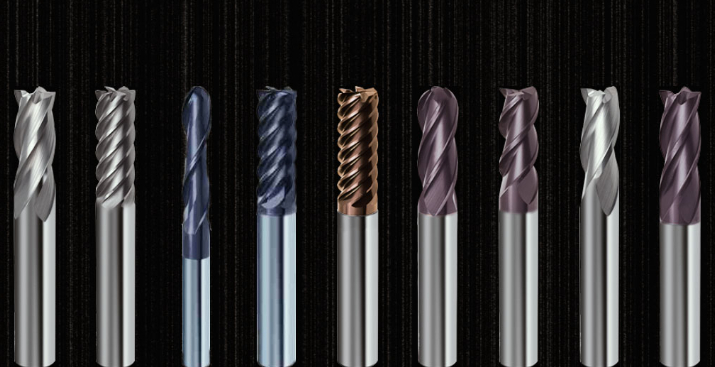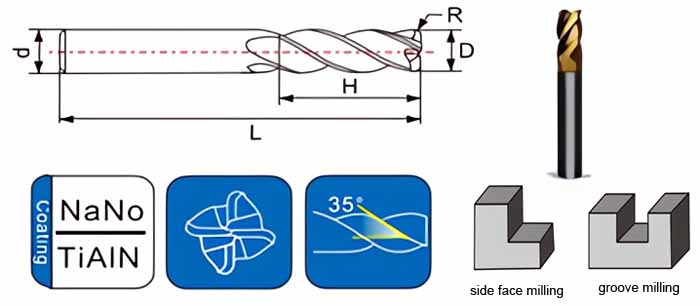はじめに4枚刃エンドミルによる汎用性の向上
4フルート エンドミル は、積極的な材料除去と滑らかな仕上げ面のバランスを実現する能力で有名な、機械加工の世界で不可欠な工具です。4つの切れ刃(フルート)は、安定性と切り屑のクリアランスを向上させ、様々な産業における幅広い用途に理想的です。この包括的なガイドでは、3つの主要なタイプの4枚刃エンドミルについて詳しく説明します: ストレートシャンクスクエアエンドミル、ストレートシャンクロングフラッシュエンドミル、ストレートシャンクラウンドエンドミルそのユニークな特徴、用途、利点を探る。

基本を理解する:4枚刃エンドミルとは?
ツールの定義
A 4枚刃エンドミル は、本体に沿ってらせん状に配置された4つのヘリカル刃(フルート)を特徴とする回転切削工具である。これらのフルートは、切屑を切削領域から遠ざけると同時に、効率的な材料除去を促進します。このエンドミルは、軸方向と横方向の両方の切削が可能な設計になっているため、様々な加工に対応できます。
4枚刃エンドミルの主な構成要素:
- カッティングエッジ: 通常、超硬合金または高速度鋼で作られた4つの精密に研磨された刃が、被削材の切削を担当する。
- フルート: エンドミル本体に沿って走るヘリカル溝は、切りくず排出のための通路となる。4枚刃により、切り屑排出性、仕上げ面粗さ、工具剛性のバランスを実現。
- シャンク: エンドミルの円筒部はフライス盤のツールホルダに固定される。
- ボディ エンドミルのメインセクションは、フルートを収容し、シャンクと切れ刃を接続します。
4枚刃エンドミルに不可欠な3つのタイプを探る
1.ストレートシャンクスクエアエンドミル一般加工の主力工具
ストレートシャンクスクエアエンドミル は、最も一般的なタイプの4枚刃エンドミルで、スクエアな切削形状とストレートシャンクが特徴です。汎用性が高く、以下のような幅広い加工に使用される:
- スロットとポケット: ワークピースに長方形の溝やポケットを作る。
- プロファイリング: ワークのエッジに輪郭やプロファイルを加工する。
- フェイシング: ワークの上面から材料を除去して平らな面を作ること。
2.ストレートシャンクロングフラッシュエンドミル:高精度で奥まで届く
ストレートシャンク ロングフラッシュエンドミルロングリーチエンドミルとも呼ばれ、特に深いキャビティや形状の加工用に設計されています。切削長を延長し、ネック径を小さくすることで、深い切削加工に適したリーチと剛性を実現しています。主な用途
- ディープ・キャビティ・マシニング 深いポケット、金型、ダイを正確に作る。
- 金型コア加工: 金型コアの複雑なディテールやフィーチャーを加工する。
- 航空宇宙部品製造: 深いキャビティと厳しい公差を持つ複雑な部品の製造。
3.ストレートシャンク ラウンドエンドミル滑らかな輪郭とRの実現
ストレートシャンク ラウンドエンドミル 丸みを帯びた切断プロファイルが特徴で、滑らかな輪郭、半径、フィレットの作成が可能です。より滑らかな仕上がりと応力集中の低減が望まれる用途によく使用される:
- 輪郭加工: 滑らかで流れるようなカーブとプロファイルを作成します。
- フィレット加工とラジアス加工: コーナーとエッジを丸く加工し、ストレスポイントを減らす。
- 金型磨き: 金型キャビティの仕上げと研磨を行い、高品質の表面仕上げを実現する。



比較分析:違いを理解する
| 特徴 | ストレートシャンク スクエアエンドミル | ストレートシャンク ロングフラッシュエンドミル | ストレートシャンク ラウンドエンドミル |
|---|---|---|---|
| 切断プロファイル | 正方形 | 正方形 | ラウンド |
| シャンクタイプ | ストレート | ストレート | ストレート |
| 全長 | スタンダード | 拡張 | スタンダード |
| ネック径 | スタンダード | 削減 | スタンダード |
| アプリケーション | 一般機械加工、スロット加工、ポケット加工、プロファイル加工、フェーシング加工 | 深キャビティ加工、金型コア加工、航空宇宙部品 | 輪郭加工、フィレット加工、R加工、金型研磨 |
| メリット | 多用途、広く入手可能、コスト効率に優れる | リーチを拡大し、深いカットのための剛性を強化。 | 滑らかな輪郭、応力集中の低減 |
| 制限事項 | 深い窩洞へのリーチは限定的 | オーバーハングが大きいとたわみやすい。 | 四角いコーナーや鋭いエッジには適さない |
業界を超えたアプリケーション:4枚刃エンドミルの汎用性
多様な加工ニーズに対応:
- 航空宇宙 エンジン部品、タービンブレード、構造要素など、公差の厳しい複雑な部品の製造。
- 自動車: エンジンブロック、シリンダーヘッド、トランスミッション部品など、精度と耐久性が要求される重要な部品を生産。
- 医療機器製造: 高精度と生体適合性を備えたインプラント、手術器具、その他の医療機器の製造。
- 金型製作: プラスチック、ダイキャスト、射出成形など様々な産業向けの複雑な金型キャビティ、中子、細部の加工。
- 一般機械加工: 機械工場や製造施設で、試作、修理、特注加工など、さまざまな作業に広く使用されている。
正しい4枚刃エンドミルの選択:主な検討事項
ツール選択に影響を与える要因:
- 加工される素材: 異なる材料には、硬度、耐摩耗性、コーティングなどの特定の特性を持つエンドミルが必要です。
- 機械加工の種類 スロット加工、ポケット加工、プロファイル加工など、特定の加工作業によって、適切なエンドミルの形状が決まります。
- カットの深さ: 深いキャビティでは、必要なリーチと剛性を確保するために、長いリーチのエンドミルが不可欠です。
- 表面仕上げの要件: 目的の仕上げ面を得るために、適切な刃数と形状のエンドミルを選択します。
- 工作機械の能力: 選択したエンドミルとの互換性を確保するために、フライス盤の主軸回転数、馬力、剛性を考慮してください。
4枚刃エンドミルのニーズにTRUERを選ぶ理由
精密工具のリーダーとの提携:
- 妥協のない品質: TRUERは、製造工程全体にわたって厳格な品質管理措置を維持し、卓越した工具の性能と寿命を保証しています。
- アプリケーション固有の専門知識: 当社の経験豊富なエンジニアチームは、お客様の特定のアプリケーションに最適な4枚刃エンドミルを選択し、効率と結果を最大化するためのガイドを提供します。
- 競争力のある価格とタイムリーな配達: TRUERは競争力のある価格を提供し、注文を迅速にお届けすることで、ダウンタイムを最小限に抑え、お客様の生産性を最大限に高めるよう努めています。
よくある質問4枚刃エンドミルに関するお問い合わせ
1.2枚刃エンドミルと比較して、4枚刃エンドミルを使用する主な利点は何ですか?
4枚刃エンドミルは、2枚刃エンドミルと比較して、安定性が向上し、切り屑排出性が改善され、一般的に滑らかな仕上げ面が得られます。そのため、特に高い切削抵抗が必要な場合、幅広い被削材や加工に適しています。
2.ストレートシャンクのラウンドエンドミルより、ストレートシャンクのスクエアエンドミルを選ぶのはどのような場合ですか?
ストレートシャンクのスクエアエンドミルは、スクエアコーナー、スロット、ポケットなどの一般的な加工に適しています。輪郭、R、フィレットを加工する場合は、ストレートシャンクのラウンドエンドミルを選びます。
3.ストレートシャンクのロングフラッシュエンドミルのネック径が小さくなっていることの意味は何ですか?
ストレートシャンクのロングフラッシュエンドミルのネック径を小さくすることで、剛性を維持しながら深いキャビティへのリーチを拡大。この設計は、工具のたわみと振動を最小限に抑え、深切り加工での精度と仕上げ面精度を向上させます。
4.4枚刃エンドミルの一般的な摩耗の兆候と、工具寿命を延ばす方法は?
一般的な摩耗の兆候には、切削抵抗の増加、表面仕上げの悪化、過度の発熱、切れ刃のチッピングや破損などがある。工具寿命を延ばすには、適切な切削パラメータを使用し、クーラントを効果的に塗布し、セットアップを厳密に維持し、工具の過度のたわみを避けることである。
5.4枚刃エンドミルの材質とコーティングを選択する際に考慮すべき点は何ですか?
加工する材料、加工作業の種類、希望する工具寿命を考慮してください。超硬エンドミルは一般的に高価ですが、硬度、耐摩耗性、高温性能に優れています。ハイスエンドミルは、費用対効果が高く、軟らかい材料の加工に適しています。TiN、TiCN、AlTiNなどのコーティングは、工具寿命、硬度、性能をさらに向上させます。
高品質の4枚刃エンドミルを適正価格で購入したいですか?クリック これ.




